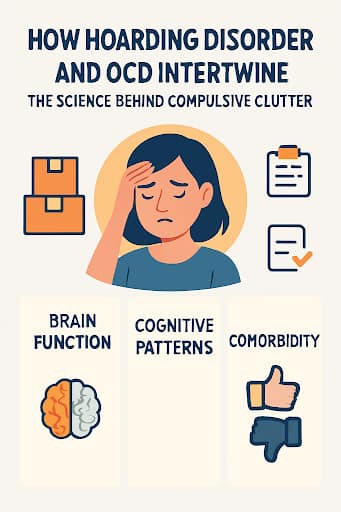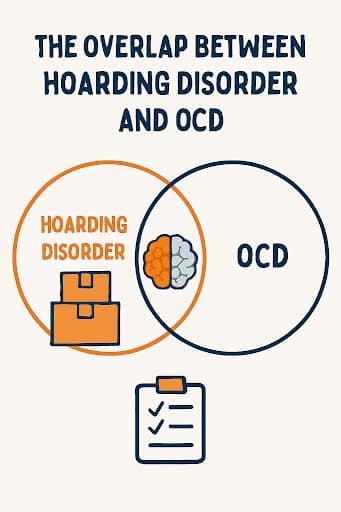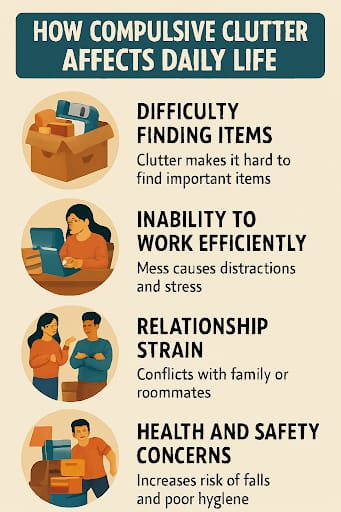
INTRODUCTION
Have you ever felt bogged down by clutter that seems impossible to throw away but not totally understood why? Hoarding Disorder and Obsessive-Compulsive Disorder (OCD) have similarities often creating a complicated relationship between saving and the anxiety induced behaviours characteristic of OCD.
Both syndromes can involve compulsive behaviours, but the motivation and behaviours involved differ and make for challenges in diagnosis and treatment. In this blog we will address the science of hoarding and OCD, as well as the neurological, psychological and emotional drivers of compulsive clutter, and what this means for the individual.
What Is Hoarding Disorder?
Hoarding disorder is a serious mental health condition that is characterized by an ongoing difficulty in getting rid of or discarding possessions of little or no value. This difficulty results in an excessive accumulation of possessions that may clutter areas of the living space and may result in not being able to use those areas or making those areas unsafe for living.
The distress experienced while trying to dispose of these possessions or accumulating them may come from strong emotional attachments to the items, fear of not being able to recover important information in the items, or fear of needing the item in the future.
- Important features of the disorder include the inability to discard possessions, experience distress or impairment in home situations, as well as accumulation of many different objects including newspapers, new/used clothing, trash, collectibles, and more importantly pets, etc.
- Hoarding is often accompanied by indecisiveness, perfectionism, procrastination, and avoidance.
The DSM-5 (Diagnostic and Statistical Manual of Mental Disorders, 5th Edition) formally identifies hoarding disorder as a separate diagnosis and is differentiated from OCD or obsessive-compulsive disorder, though co-occurrence is common.
Understanding OCD
Obsessive-Compulsive Disorder (OCD) is a mental illness involving obsessions and compulsions.
- Obsessions can be ideas, thoughts, images, or urges that are intrusive and unwanted and create significant anxiety or distress (e.g. fear of contamination, harming another person, or needing things to be perfectly symmetrical).
- Compulsions involve engaging in behaviors or mental acts repeatedly to reduce anxiety or prevent a feared situation (e.g. wash hands multiple times, check again and again, change laying out the objects repeatedly).
OCD will affect approximately 1-2% of the population and involves lengthy rituals leading to significant distress and impairment in daily functioning.
The Overlap Between Hoarding Disorder and OCD

Hoarding disorder and obsessive-compulsive disorder (OCD) are not the same but they do have some features in common.
- Both hoarding disorder and OCD involve compulsive behavior; in OCD, the compulsions are carried out to eliminate the anxiety generated from intrusive obsessions, whereas in hoarding disorder, the compulsive acquiring and saving helps reduce the anxiety about throwing items away.
- Both can also include intrusive thoughts, with OCD having unwanted obsessions and the intrusive thoughts in hoarding disorder resulting in worries about tossing valuable items or making poor decisions.
- Both disorders can cause emotional distress, leading to social isolation, the inability to function in daily life, and strained relationships.
- Some of the studies have indicated that there is a considerable overlap between the two, with 20-40% of people with OCD, showing hoarding-like symptoms, and some individuals with hoarding disorder displaying mild obsessive-compulsive disorder (OCD) traits and support the interconnectedness of the two.
How Hoarding Disorder Differs From OCD
Hoarding disorder is different from OCD in several ways.
- First, while OCD obsessions are less consistent and often irrational (like fears of getting contaminated or impulses of violence), hoarding obsessions are concrete (Having to do with possessions and fears of losing something valuable or being wasteful).
- Second, OCD compulsions are related to decreasing anxiety stemming from the obsession, while hoarding behavior originates from an emotional attachment to the possessions and the perceived utility or sentimental value of the items.
- Third, in individuals with a hoarding disorder, there are significant cognitive and executive function deficits in decision making, categorization, organization and judgment that lead to procrastination and poor insight, which are less prevalent in “classic OCD.”
- Fourth, emotional attachment to the possessions is a key feature of hoarding that is not typically associated with classic OCD patterns.
Neuroscience Behind Hoarding and OCD
1. Brain Regions Implicated in OCD
Abnormal hyperactivity in several regions of the brain can contribute to the symptoms of Obsessive-Compulsive Disorder (OCD) in persons with the disorder.
- The orbitofrontal cortex (OFC) displays hyperactivity that may cause over-estimation of potential threats and result in over-deterioration of decision-making.
- Anterior cingulate cortex (ACC) features hyperactivity that may support error monitoring and can trigger heightened emotional response to a perception, resulting in hyper-attention to a possible problem or heightened excitement about not doing anything wrong but perceiving that “something’s not quite right.”
- The basal ganglia, which also plays a role in motor processes related to stereotypic and habitual behaviors, plays a role with obsessive-compulsive behaviors related to compulsions.
While there appears to be greater dysfunction when these brain regions run together, it is not fully understood how hyperactivity in these three regions can all lead to the intrusive thoughts and ritualized behaviors (or compulsions) consistent with obsessions in OCD.
2. Brain Regions Implicated in Hoarding
There are some distinct patterns of brain activity that differentiate hoarding disorder from OCD, particularly in areas associated with emotion and decision-making.
- The anterior cingulate cortex (ACC) has shown different activation patterns indicating differing emotional processing around the items in question.
- The insula, which is associated with emotional attachment and an awareness of the self, is especially more active in people with hoarding disorder suggesting stronger emotional connections to their items.
- The decreased activity of the prefrontal cortex, which is involved in decision-making and executive function, would interfere with the ability to make clear decisions regarding whether an item should be discarded.
This neurological make-up demonstrates how hoarding behaviours are more associated with emotional significance rather than anxiety or fear.
How Compulsive Clutter Affects Daily Life

Compulsive clutter resulting from hoarding disorder creates interruptions in activities of daily living and various life domains.
- Physical health and safety risks are prevalent, as clutter can lead to falls, fire risk, unsanitary conditions, and infestations from pests.
- Socially, isolation can take place, as shame and embarrassment over living spaces often precipitate avoiding visitors and withdrawing from family and friends.
- Occupationally, hoarding can create impairment as maintaining employment and adequate management of finances can be impeded by a dysfunctional home environment.
- Emotionally, hoarding correlates with chronic anxiety, chronic depression, and a sense of hopelessness.
Likewise, untreated OCD and severe distress has been shown to hinder relationships, jobs, and general wellbeing making the need for early intervention necessary for both conditions.
Final Thought
Hoarding Disorder and OCD have many common compulsive features, they are both separate disorders with distinct neural and psychological aspects.
- While hoarding is primarily motivated by an emotional attachment and provokes poor decision-making.
- OCD is motivated by anxiety-associated obsessions and compulsions.
- Different manifestations of compulsive behavior can disrupt function, our relationships with each other, and overall emotional state.
Understanding the relevant research concerning the science behind Hoarding Disorder and OCD – brain function, attachment and compulsive behavior – may influence diagnosis and interventions.
Reference
- Hoarding disorder. Cleveland Clinic. https://my.clevelandclinic.org/health/diseases/17682-hoarding-disorder
- What is Hoarding Disorder? (n.d.). https://www.psychiatry.org/patients-families/hoarding-disorder/what-is-hoarding-disorder
- Obsessive-compulsive disorder (OCD) – Symptoms and causes. (n.d.). Mayo Clinic. https://www.mayoclinic.org/diseases-conditions/obsessive-compulsive-disorder/symptoms-causes/syc-20354432
- Tolin, D. F., Witt, S. T., & Stevens, M. C. (2013). Hoarding disorder and obsessive-compulsive disorder show different patterns of neural activity during response inhibition. Psychiatry Research, 221(2), 142. https://doi.org/10.1016/j.pscychresns.2013.11.009
- Wu, K. D., & Watson, D. (2005). Hoarding and its relation to obsessive–compulsive disorder. Behaviour Research and Therapy, 43(7), 897-921. https://doi.org/10.1016/j.brat.2004.06.013
- Grisham, J. R., & Baldwin, P. A. (2015). Neuropsychological and neurophysiological insights into hoarding disorder. Neuropsychiatric Disease and Treatment, 11, 951. https://doi.org/10.2147/NDT.S62084
- Saxena, S. (2008). Neurobiology and treatment of compulsive hoarding. CNS Spectrums, 13(S14), 29–36. https://doi.org/10.1017/s1092852900026912






